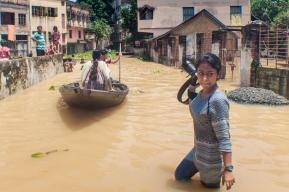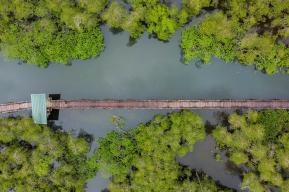观点
澳大利亚:山火过后

2019年和2020年,在新南威尔士州和维多利亚州肆虐的山火造成了惨重损失,远超预计,数百万公顷植被摧毁殆尽,近三十亿只动物葬身火海或痛失家园。专家称,要恢复澳大利亚的生物多样性,将要耗时多年,而且需要人工干预。如果天气状况持续不利,投入的精力会更大。
加里·纳恩(Gary Nunn)
驻悉尼自由撰稿人
“当你走进一片被彻底焚毁的森林,首先感受到的是笼罩四周的寂静,没有鸟儿鸣唱,没有树叶沙沙作响,只有一片死寂。”墨尔本拉筹伯大学动物学教授迈克·克拉克(Mike Clarke)这样描述近日毁于丛林大火的澳大利亚多处森林,这是该国有史以来最严重的一场火灾。
克拉克说:“这是澳大利亚有史以来最严重的灾难。”过火面积高达1300万公顷,单看这个数字“很难形成具体概念”,换种表达方式:森林受灾面积超过荷兰、丹麦和瑞士国土面积总和。曾经的郁郁葱葱,如今尽成焦土,所有房屋、森林、动物、植物荡然无存。
如果再考虑到另一个重要因素——时机,就更能了解这场火灾的影响程度何其之深。克拉克说:“在山火爆发之前,澳大利亚刚刚经过了有记录以来最干旱的年份。由于干旱,动物种群已经岌岌可危。澳大利亚今后三四年的天气状况对于复苏程度至关重要。”
损失空前
受世界自然基金会(WWF)委托,2020年7月,来自五家机构的十位科学家展开了一场调研,结果显示,有三十亿只动物葬身火海或失去家园。澳洲科学院院士、悉尼大学陆地生态学教授克里斯托弗·迪克曼(Christopher Dickman)负责监督该项目,他说,看到调研的主要结果,就连研究人员也大吃一惊。他在《卫报》的采访中说道:“三十亿本土脊椎动物,这个数量太庞大了,大到超出了理解范围。”
但克拉克认为这是保守估计:“那只是哺乳动物、鸟类和爬行动物的数量。如果再加上无脊椎动物,将是天文数字。”
不过,有一件事必须说明,澳大利亚的丛林大火一直都很严重。墨尔本大学火灾生态学教授艾伦·约克(Alan York)说:“事态的严重程度并非前所未有。但史无前例的是,这次的山火比往年的火灾多发季节来得要早,而且多处同时燃起大火,这种情形非常罕见。”
对于澳大利亚的濒危物种来说,此次山火的影响可能是毁灭性的。克拉克说,有70个国家级濒危物种的栖息地至少被大火烧毁了一半,这其中包括长脚长鼻袋鼠和袋鼠岛上的辉凤头鹦鹉—— “这是一种珍稀的美丽鸟类。”他补充道。山火要么烧毁了它们的食物来源,要么烧毁了它们的栖息地,甚至,将二者同时化为灰烬。
在新南威尔士州北部,考拉的大部分栖息地尽数毁于山火。克拉克认为,由于这些动物具有标志性意义,有时会让人们忽视生态系统中其他触目惊心的惨状,“考拉成了这场危机中受灾动物的典型代表。但实际上,所有野生动植物(大负鼠、生长在高山桉树林中的各类植物、乃至整个生物群落)现在都处于危险中”。
澳大利亚丛林复原力存疑
这些物种要再次恢复生机,可能需要数年时间,而且可能需要人类伸出援手,例如在澳大利亚动物园中人工繁殖青蛙。约克解释说:“否则的话,我们只能寄希望于动物能够在幸免于火灾的零星土地上存活下来。”他对此抱有一定的乐观态度,认为澳大利亚的丛林蕴含着“非凡的恢复能力”。
然而,警告依然存在。约克说,塔斯马尼亚岛的热带雨林和高山地区极少发生山火,这些地区的火灾应对经验较少,因而更容易遭受山火的反复袭扰。在当前的气候变化模式下,丛林大火增多的势头是不可避免的。
在当前的气候变化模式下,丛林大火增多的势头是不可避免的
最有可能妨碍生态系统恢复的几种“人为干扰”包括:为开垦土地而侵占栖息地,以及不立刻采取应对气候变化的政治行动。
不过,澳大利亚丛林的复原力真的可以让其生态恢复如初吗?并非人人都同意这位火灾生态学家谨慎的乐观态度。克拉克说:“大火烧毁了70%的热带雨林,而雨林地带还没有学会适应大火。人们目前完全不知道雨林能不能恢复、如何恢复。”
大火烧毁了70%的热带雨林
生态恢复需数百年
问题是,许多重要资源被付之一炬。例如,凤头鹦鹉、鹦鹉、负鼠、蝙蝠等许多动物在筑巢和繁殖时都需要以地面上的空心木桩或树木为据点。克拉克预测,这些空心木桩已尽毁于大火,而新的空心木桩的形成需要一两百年的时间。“丛林大火在短短几个小时内所吞噬的,可能要过几个世纪才能复原。生态学家称之为‘彻底改变状态’。”
对生态恢复至关重要的一个因素是土壤。由于近年来的旱灾吸干了土壤中原有的水分,在这次火灾中燃烧的土壤比以往要多,这意味着土壤中包含的基本营养元素已不复存在。
需要立即采取措施
专家指出,为帮助这片广袤的地区恢复原貌,目前正采取一些紧急措施。已经有人建议暂停伐木;同时各方还在施加压力,要求不但要清除杂草,还要针对野猫和狐狸采取更加积极的虫害防治工作。约克解释说:“复生的杂草占据了过火地区,挤占了本地动植物可能需要的资源。”
确定并保护没有发生山火的地区是另一项重要的辩论议题。具体说来,一些人认为文化焚烧要优于温度更高、火势更猛的减险焚烧。文化焚烧的温度较低,火焰只有半人高,通过人为设计令整片地区持续燃烧。早在澳大利亚先民来此殖民之前很久,土著居民就采用了这种做法。利用火将各种引火物和杂草落叶燃烧掉,自然发生的丛林大火相应地就少了很多助燃物。
自2019年澳大利亚山火引发危机以来,要求更好地采用这种技术的呼声越来越强烈。但克拉克认为,在当前的危机时刻,文化焚烧的作用可能很有限:“我们必须认识到,现在的情况不同于以往。之前,文化焚烧是为了在茂密的植被中开辟出一条路或是为了举行某种仪式。现如今,国内居民多达2500万,复杂的基础设施纵横交错,而且气候变化已成问题,文化焚烧绝非良策。”
应对气候变化的具体措施对于生物多样性的未来前景至关重要。有些地方出现了一丝乐观情绪,但从现有预测来看,丛林的生物多样性能否恢复如初,前景一片黯淡。克拉克对此作了较为详细的推测:“大部分会表现不错——三分之一能够复原,三分之一目前还不能确定,但另外三分之一问题严重。我研究火灾生态学有20年了,但这依然是一个变化莫测的未知领域。”
拓展阅读:
《澳大利亚水革命》,联合国教科文组织《信使》,2009年3月
《煽动贪婪的火焰》,联合国教科文组织《信使》,1998年7-8月
《用于评估和适应气候变化的土著知识》,联合国教科文组织和剑桥大学出版社,2018年
订阅联合国教科文组织《信使》,阅读发人深省的时事文章,数字版免费。
在社交网络上关注联合国教科文组织《信使》:微博、微信公众号“联合国教科文信使”、Twitter、Facebook、Instagram。
Gary Nunn
Freelance journalist, based in Sydney.
“When you walk into a forest that’s been burnt this badly, the overwhelming thing that hits you is the silence. No bird-song. No rustling of leaves. Silence.” This is how Mike Clarke, professor of zoology at La Trobe University, Melbourne, described Australia’s many forests that were recently decimated by the country’s worst bushfires.
“This stands out as the worst disaster in Australia’s recorded history,” Clarke says. The figure of the area that has been burnt – 13 million hectares – is “hard to get your head around.” For scale, this is an area bigger in hectares than Holland, Denmark and Switzerland combined. All burnt to a crisp. Homes, forests, animals, plants – all gone.
The timing is also significant in understanding the scale of the impact. “This comes on top of Australia’s driest years on record,” Clarke adds. “Populations of animals were already on their knees due to the drought. Australia’s weather conditions in the next three or four years will be critical to what recovery looks like.”
Unprecedented losses
Three billion animals were killed or displaced in the bushfires, according to a July 2020 study by ten scientists from five institutions commissioned by the World Wildlife Fund for Nature (WWF). Christopher Dickman, professor in terrestrial ecology at The University of Sydney and fellow of the Australian Academy of Science, who oversaw the project, said the study’s main findings came as a shock, even to the researchers. “Three thousand million native vertebrates is just huge. It’s a number so big that you can’t comprehend it,” he told The Guardian newspaper.
This figure is conservative, Clarke believes. “That’s just mammals, birds, reptiles. If we added invertebrates to that, the numbers would be astronomical.”
One thing that must be clear, though, is that Australia’s bush has always burnt quite severely. “The severity isn’t unprecedented,” says Alan York, professor of Fire Ecology at the University of Melbourne. “What is unprecedented is their earliness in, or before, the usual fire season, and the volume of fires in so many places, which is far more unusual.”
The impact on Australia’s threatened species is potentially devastating. Seventy nationally threatened species have had at least half of their habitat burnt, Clarke says. These include animals such as the long-footed potoroo and the Kangaroo Island’s glossy black-cockatoo – “a rare and spectacular bird,” he adds. Fires have burnt their food sources, shelter, or both.
Koalas in northern New South Wales have had most of their habitat burnt. The iconic nature of these animals sometimes overshadows other ecosystem horrors, Clarke says. “They’re the poster child of this crisis. But in reality, a whole suite of wildlife – large possums, all sorts of plants that live in alpine ash, whole communities of organisms – are all at risk now.”
How resilient is the Australian bush?
It may take years for these species to recover. And that may require human assistance – with captive-bred frogs in Australia’s zoos, for example. “Otherwise, we’re hoping animals survived in unburnt pockets,” York explains. He remains somewhat optimistic, saying the Australian bush has a “dramatic capacity to recover.”
There are, however, caveats. Rainforests and alpine areas of Tasmania, for instance, don’t have much experience of fires, so they’re more vulnerable to repeated fires, he says. And under the current climate change model, increasing fires are inevitable.
Under the current climate change model, increasing fires are inevitable
Some of several “human interferences” that’ll most likely hamper recovery include habitat removal from land clearing, and a lack of urgent political action on climate change.
But is the Australian bush really resilient enough to recover? Not everyone shares the fire ecology expert’s tempered optimism. “Seventy per cent of the rainforest has been burnt – it’s the bit of the landscape not adapted to fire – so it’s really unclear how, and if, it’ll come back,” Clarke says.
Seventy per cent of the rainforest has been burnt
A recovery could take centuries
The problem is, lots of critical resources have been incinerated. For example, many fauna – cockatoos, parrots, possums, bats – rely on hollow logs on the ground, or on trees to den in or breed in. Not only have those logs now gone, Clarke predicts that it will take one to two centuries for them to appear again, hollowed out. “What could disappear in hours in bushfire could take centuries to replace. Ecologists would call this a ‘complete state change’.”
An essential ingredient to recovery is soil. More soil than usual was burnt in these fires, as the droughts in recent years removed the pre-existing moisture. This means the essential nutrients held in the soil are no longer there either.
Immediate measures needed
Experts say some immediate steps are being taken to help along the recovery of this vast area. A moratorium on logging has been proposed, and pressure is building to act more aggressively on the pest control of feral cats and foxes, in addition to introducing weed removal. “Weeds recolonize areas disturbed by fire. They use resources that native plants and animals might need,” York explains.
Identifying and protecting areas that did not burn is also an important subject for debate. Specifically, some are arguing that cultural burns may be better than the hotter, more intense, hazard reduction burning. Cultural burns are cool-burning, knee-high blazes that were designed to happen continuously and across the landscape, practised by indigenous people long before Australia’s invasion and colonization. The fires burn up fuel like kindling and leaf detritus, so that a natural bushfire has less to devour.
Since Australia's fire crisis began in 2019, calls for better reintegration of this technique have grown louder. But they may be of limited value at this crisis point, according to Clarke. “We need to appreciate how different things are now. Cultural burns happened to enable people to move through dense vegetation easily, or for ceremonial reasons. They weren’t burning around 25 million people, criss-crossed by complex infrastructure and in a climate change scenario,” he estimates.
Concrete measures to combat climate change are indeed crucial for the future of biodiversity. In spite of green shoots of optimism in some quarters, the prognosis of whether the bush will ever recover its biodiversity is looking somewhat grim. Breaking it down, Clarke surmises that “A chunk of it will be good – a third will be able to bounce back. A third is in question, but a third is in serious trouble. I’ve been studying fire ecology for twenty years, but we’re dealing with unchartered territory changing before our eyes.”







